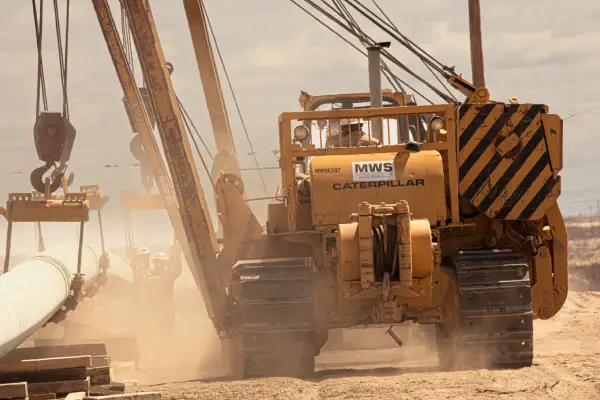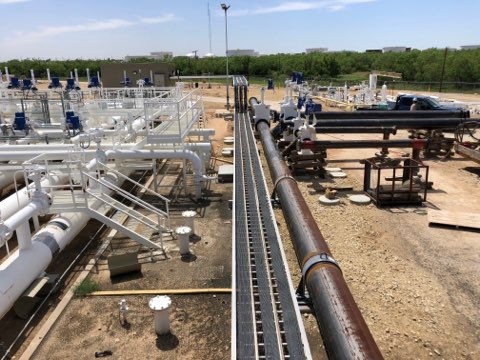How Long Should Pipeline Construction Services Take? Key Timeline Insights
Discovering the most recent Innovations in Pipeline Construction Providers for Modern Projects
The Pipeline Construction industry is going through substantial changes. Developments such as wise products and robotics are improving traditional techniques. These developments guarantee to enhance effectiveness and safety. Furthermore, AI modern technologies are enhancing job management capacities. As these elements converge, they increase concerns about their lasting effect on sustainability and price. Understanding these developments is vital for stakeholders aiming to browse this advancing landscape. What effects do they hold for future jobs?
The Increase of Smart Materials in Pipeline Construction
As the need for extra lasting and reliable Pipeline systems raises, the combination of wise materials has emerged as a transformative remedy in Pipeline Construction. These advanced materials possess unique properties that boost the performance and longevity of pipes. Self-healing polymers can instantly fix minor leaks, substantially reducing maintenance prices and downtime. Additionally, materials installed with sensing units can keep track of structural integrity and ecological conditions, permitting real-time information collection and analysis.
Smart materials are corrosion-resistant and usually light-weight, which not only streamlines installment but also expands the life-span of the systems. Their flexibility allows pipelines to withstand severe ecological conditions, promoting security and dependability. As markets increasingly prioritize sustainability, using environment-friendly smart products adds to minimized ecological influence. Overall, the increase of clever products notes a remarkable change in Pipeline Construction, paving the way for innovative remedies to satisfy contemporary infrastructure demands.
Developments in Robotics for Installation and Maintenance
The combination of smart materials in Pipeline Construction is enhanced by innovations in robotics, which are transforming setup and upkeep procedures. Robot modern technologies, such as automated welding systems and drones, improve efficiency and precision, minimizing human mistake and minimizing security risks. These robotics can operate in difficult atmospheres, guaranteeing that setups are performed in remote or dangerous locations without putting workers at risk.
In addition, robotic examination devices geared up with innovative sensors supply real-time information on Pipeline stability, permitting for proactive maintenance. They can discover leakages or architectural weaknesses, enabling timely interventions that expand the life expectancy of Pipeline systems. Making use of robotics not just increases the Construction timeline yet also optimizes source appropriation, causing cost savings. As these technologies continue to advance, they are readied to play a critical role in shaping the future of Pipeline Construction, guaranteeing integrity and sustainability in framework growth.
AI-Driven Job Management Tools Transforming Workflow
AI-driven task management tools are reshaping workflows in Pipeline Construction by boosting decision-making processes with improved access to real-time data analytics. These tools enable teams to react quickly to job growths, therefore raising efficiency. Streamlined interaction channels foster collaboration among stakeholders, better optimizing job end results.
Improved Decision-Making Processes

Real-Time Information Analytics
Taking advantage of real-time data analytics, modern job monitoring tools revolutionize process in Pipeline Construction. These advanced tools leverage fabricated intelligence to offer immediate understandings right into project performance, resource allocation, and possible risks. By continuously monitoring key efficiency indicators, teams can quickly adapt to changing conditions, enhancing labor and materials use. The integration of real-time information permits for even more educated decision-making, reducing delays and minimizing costs. Furthermore, predictive analytics can recognize trends and projection obstacles prior to they escalate, enhancing general project efficiency. Therefore, Pipeline Construction firms that take on these AI-driven tools can boost task timelines and results, ensuring they remain affordable in a significantly intricate sector landscape. This advancement notes a significant change towards data-centric management techniques.
Streamlined Interaction Channels
Reliable communication is extremely important in Pipeline Construction, where many stakeholders need to collaborate effortlessly to guarantee job success. The introduction of AI-driven task monitoring devices has changed communication networks within the industry. These devices promote real-time info sharing, allowing groups to gain access to updates, share records, and track progression efficiently. By automating routine jobs and providing a centralized platform for interaction, these innovations get rid of misunderstandings and lower delays. Enhanced exposure into job timelines and resource allotment promotes liability amongst employee. Furthermore, AI analytics can identify prospective communication spaces, making certain aggressive problem-solving. Inevitably, structured communication networks not only enhance operations yet also boost total job performance, making it possible for Pipeline Construction companies to fulfill modern-day needs efficiently.
Boosted Safety And Security Protocols With Technology Combination
The integration of innovation in Pipeline Construction has actually brought about enhanced safety protocols. Real-time monitoring systems, wearable safety devices, and automated risk assessments are now crucial parts in reducing threats on task websites. These developments not only enhance employee safety however additionally enhance conformity with market regulations.
Real-Time Surveillance Solutions
Just how can real-time monitoring systems change Pipeline Construction security protocols? By incorporating innovative innovation, these systems provide continual surveillance of Construction tasks, ensuring immediate detection of potential hazards. Sensors and cameras can keep an eye on ecological problems, devices efficiency, and labor force activities, delivering crucial data in actual time. This positive approach permits job managers to recognize dangers prior to they intensify, greatly boosting precaution on-site. Furthermore, real-time surveillance assists in conformity with regulatory needs, making certain that security criteria are fulfilled constantly. The capacity to evaluate information instantly sustains educated decision-making, allowing prompt treatments. Therefore, Pipeline Construction tasks can run extra successfully while safeguarding the he said well-being of employees and lessening crashes, consequently changing the industry's safety and security landscape.
Wearable Safety And Security Gadgets
Regularly, wearable safety tools are being integrated into Pipeline Construction to improve safety and security methods. These ingenious devices, consisting of clever helmets, vests, and wristbands, are made to check worker wellness and environmental conditions in real-time. Equipped with sensors, these tools can identify dangers such as harmful gas exposure, excessive heat, or high sound levels, giving instant signals to managers and employees. Additionally, wearable innovation usually includes GPS tracking functions, permitting efficient location tracking of workers on-site. This capability not only help in fast action during emergency situations however additionally boosts total project management. By focusing on employee safety and security through modern technology integration, Pipeline Construction business are making considerable strides in lowering crashes and advertising a culture of safety and security within the industry.

Automated Danger Evaluations
While typical risk analyses commonly rely upon manual evaluations, the combination of computerized threat evaluation innovations is changing security procedures in Pipeline Construction. These innovative systems leverage information analytics, expert system, and artificial intelligence to determine prospective threats extra precisely and effectively. By continually keeping an eye on ecological conditions, tools standing, and worker habits, automated analyses give real-time insights that enhance decision-making. This proactive technique decreases the likelihood of crashes and boosts compliance with security laws. In addition, automated danger evaluations can be upgraded instantly, making certain that all stakeholders have accessibility to the most recent information. Consequently, Pipeline Construction jobs profit from a safer job atmosphere, minimizing disruptions and promoting a culture of security with modern technology assimilation.
Lasting Practices in Pipeline Construction
As the demand for energy facilities climbs, the Pipeline Construction sector significantly focuses on lasting methods that reduce environmental impact. Companies are adopting green products and sophisticated Construction techniques to reduce their carbon impact. As an example, making use of trenchless technology enables Pipeline installment with marginal disturbance to the surrounding atmosphere, reducing and protecting natural habitats dirt disintegration.
In addition, the application of renewable power resources, such as solar or wind, to power Construction activities is gaining grip. This change not only decreases dependence on nonrenewable fuel sources however additionally improves the total sustainability of Pipeline projects. In addition, effective waste administration practices, consisting of reusing and recycling materials, are becoming criterion in the industry.
Real-Time Surveillance and Anticipating Maintenance Solutions
The change towards sustainable practices in Pipeline Construction has led the way for link the integration of real-time surveillance and anticipating maintenance solutions. These modern technologies utilize progressed sensing units and data analytics to continuously examine Pipeline integrity and operational efficiency. By gathering data in genuine time, drivers can spot anomalies such as leaks or stress decreases prior to they intensify into major concerns. This aggressive approach not only minimizes ecological risks however also lowers downtime and upkeep prices.
Predictive upkeep employs formulas to anticipate possible failings based on historic information and current efficiency metrics. This allows timely treatments, enhancing upkeep timetables and resource allocation. In general, real-time surveillance and anticipating upkeep services stand for a significant advancement in Pipeline Construction, improving safety and reliability while supporting sustainability objectives. As sectors remain to welcome these innovations, the operational landscape of Pipeline management is established to develop dramatically, making certain long-term practicality and performance.
The Role of Drones in Evaluating and Assessment
Drones have arised as transformative devices in the surveying and examination of pipelines, using improved effectiveness and accuracy. Their ability to record high-resolution photos and videos from numerous angles permits complete evaluations of Pipeline integrity without running the risk of human security. Equipped with innovative sensors and thermal imaging capacities, drones can spot leaks, rust, and structural abnormalities that might not be noticeable to the nude eye.
In addition, the implementation of drones considerably minimizes assessment time, enabling quicker decision-making for maintenance and repair work. This performance converts to cost financial savings and minimal disruption to bordering atmospheres. Drones can additionally access hard-to-reach areas, such as elevated structures or rugged surfaces, further broadening the range of examinations.
As the Pipeline industry continues to accept technical advancements, the integration of drones right into surveying and inspection procedures is anticipated to grow, establishing new requirements for functional quality and safety and security in Pipeline Construction services.
Regularly Asked Questions
What Are the Prices Connected With Modern Pipeline Construction Innovations?
The costs connected with modern Pipeline Construction advancements typically consist of advanced materials, specialized labor, and sophisticated innovation. These aspects add to greater preliminary investment, yet can cause long-lasting savings with enhanced efficiency and lowered maintenance needs.
Just How Do Regulative Changes Influence Pipeline Construction Technologies?
Regulatory adjustments substantially impact Pipeline Construction technologies by demanding the adoption of safer, a lot more reliable methods. Conformity requirements often drive advancement, resulting in developments in products, design, and Construction techniques that enhance total project sustainability and safety and security.
What Abilities Are Required for Careers in Advanced Pipeline Construction?

Careers in advanced Pipeline Construction require know-how in design principles, task management, safety and security protocols, and environmental guidelines. In addition, skills in modern technology assimilation, teamwork, and analytical are important for going across the intricacies of modern framework projects.
Exactly How Can Business Make Sure Compliance With Environmental Requirements?
To assure conformity with environmental standards, companies ought to carry out strenuous training programs, perform regular audits, and embrace ideal methods in sustainability. Involving with stakeholders and monitoring governing modifications even more strengthens their commitment to ecological stewardship.

What Are the Secret Challenges Dealing With Pipeline Construction Today?
The key difficulties encountering Pipeline Construction today include governing compliance, useful link environmental problems, varying product expenses, labor scarcities, and the requirement for innovative modern technology combination (Pipeline Construction Services). These factors complicate task timelines and general performance in the market
As the need for more sustainable and effective Pipeline systems increases, the combination of smart materials has actually emerged as a transformative solution in Pipeline Construction. AI-driven project monitoring tools are improving operations in Pipeline Construction by boosting decision-making procedures via better accessibility to real-time information analytics. While job management in Pipeline Construction has actually generally relied on hand-operated procedures, the combination of advanced devices substantially boosts decision-making capacities. Taking advantage of real-time data analytics, modern-day project administration tools reinvent process in Pipeline Construction. Careers in innovative Pipeline Construction need experience in design principles, project administration, safety and security procedures, and environmental regulations.